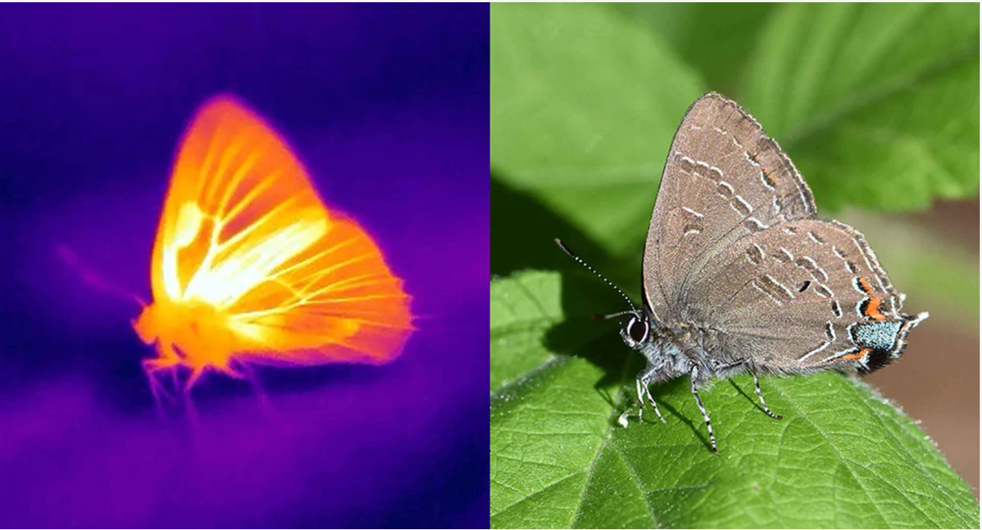BIOFLow International Research Experience for Students (IRES)
Mailing Address
Cleveland State University, Washkewicz College of Engineering
2121 Euclid Ave., WH 305
Cleveland, Ohio 44115-2214
Campus Location
Washkewicz Hall Room 305
2300 Chester Avenue
Phone: 216-687-2555
Fax: 216-687-9280
engineering@csuohio.edu
Website Issues Only
engineering@csuohio.edu
Thermal Infrared Imaging: Body Temperature and Field Metabolic Rate of Arthropods
Background.
Field metabolic rate, the integrated rate at which wild animals use energy, shapes physiology and ecology. Metabolic rate determines resource requirements, key life history traits, such as growth, development, movement, and reproduction, and the geographic distributions and abundances of animals1. A diversity of methods has been developed to measure metabolic rate of animals in the field, however, these are limited by the need to capturing, marking, and recapturing individuals in the field, all of which inevitably disturb animals2,3.
Body temperature is a valuable parameter when assessing animal thermoregulation and their responses to environmental change. Both infrared thermometry (picture) and thermography (video) offer non-invasive approaches to record body temperature and study thermoregulatory responses of a diversity of wild animals3. For small ectothermic animals like arthropods, surface temperatures, captured by these devices, are usually highly correlated with internal body temperatures4 (Figure 1). However, body temperature in the field, and thus, metabolic rate, can be influenced by environmental conditions, as well as animal body mass, and the type and level of activity3,5. Thermal imaging is increasingly applied to wildlife, however, there is a need for better understanding on how these thermal parameters may affect animal thermography in the field.
This project aims to determine the effects of key parameters (ambient temperature, wind, animal size, activity, light emissivity calibration) in the thermography of arthropods (insects and spiders) using controlled lab experiments and field testing. The use of standardized field thermography for small ectothermic animals would allow for a better understanding of the interaction between ectotherm body temperature and environmental conditions as means to estimate field metabolic rates. This is particularly important given the ongoing environmental changes and the increased thermal selection pressures imposed by growing urban environments on the urban biodiversity.

Figure 1. Thermal imaging of a butterfly. Image credit: Nanfang Yu and Cheng-Chia Tsai6
IRES student involvement
Dr. González will work with an IRES student focusing on the principles of thermoregulation and the metabolic rate of arthropods. This project aims to determine the effects of key parameters (wind speed, air temperature, animal size, activity) in arthropod body temperature, and thus metabolic rate using controlled lab experiments and field measurements. In animals, infrared thermal imaging is used to measure the temperature of a living organism based on the infrared radiation (wavelength 2–14 μm) emitted by its body7. Students will test the (i) best way of calibration of the thermal image camera with given light emissivity parameters (e.g., black box with emissivity = 1); (ii) quality of thermographic image; (iii) reflected temperature measurement; (iv) environmental temperature measurements; (v) environmental humidity measurements; and (vi) distance between the camera and thermography target (following7). Students will use experiments, image processing and computational methods to test, quantify and validate field measurements.
References.
1. Brown, J. H., Gillooly, J. F., Allen, A. P., Savage, V. M. & West, G. B. Toward a Metabolic Theory of Ecology. Ecology 85, 1771–1789 (2004).
2. Butler, P. J., Green, J. A., Boyd, I. L. & Speakman, J. R. Measuring metabolic rate in the field: the pros and cons of the doubly labelled water and heart rate methods. Funct. Ecol. 18, 168–183 (2004).
3. McCafferty, D. J., Gallon, S. & Nord, A. Challenges of measuring body temperatures of free-ranging birds and mammals. Anim. Biotelemetry 3, 33 (2015).
4. Svensson, E. I., Gomez-Llano, M. & Waller, J. T. Selection on phenotypic plasticity favors thermal canalization. Proc. Natl. Acad. Sci. 117, 29767–29774 (2020).
5. Pincebourde, S., Dillon, M. E. & Woods, H. A. Body size determines the thermal coupling between insects and plant surfaces. Funct. Ecol. 35, 1424–1436 (2021).
6. Tsai, C.-C. et al. Physical and behavioral adaptations to prevent overheating of the living wings of butterflies. Nat. Commun. 11, 551 (2020).
7. Harrap, M. J. M., Hempel de Ibarra, N., Whitney, H. M. & Rands, S. A. Reporting of thermography parameters in biology: a systematic review of thermal imaging literature. R. Soc. Open Sci. 5, 181281 (2018).
Mailing Address
Cleveland State University, Washkewicz College of Engineering
2121 Euclid Ave., WH 305
Cleveland, Ohio 44115-2214
Campus Location
Washkewicz Hall Room 305
2300 Chester Avenue
Phone: 216-687-2555
Fax: 216-687-9280
engineering@csuohio.edu
Website Issues Only
engineering@csuohio.edu